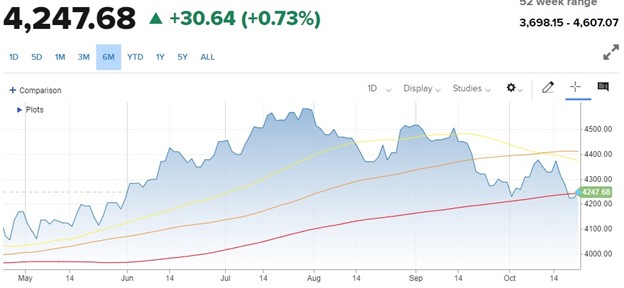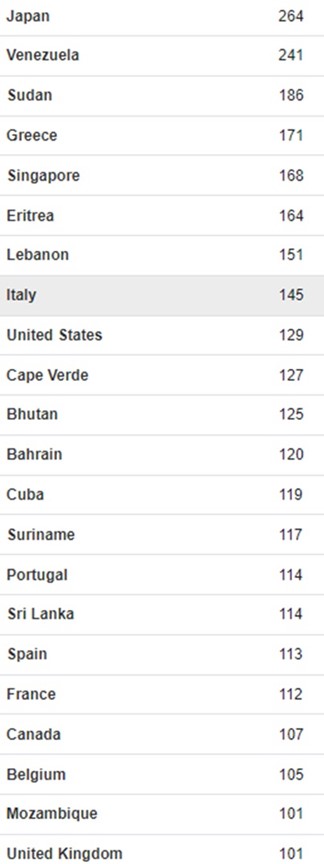Sometimes the investing landscape is incredibly simple. Like 85% of your lifetime the economy has been expanding and the stock market is bullish, states Steve Reitmeister of Reitmeister Total Return.
Then from that period of excess a recession comes along creating a bear market the other 15% of the time. Each is easy to see when you are in the middle of that phase. Unfortunately, it is rather more difficult to know which it is for sure at the cusp of where the two periods meet. And that is where we find ourselves today.
On top of that, we have an economic boogeyman that has been swept under the rug time after time and has reared its ugly head once again. At some point, we will have to pay the piper for this with a long-term period of below-trend growth and weak stock prices.
Has that dreadful time arrived?
That and more will be at the heart of this week's Reitmeister Total Return commentary.
Market Commentary
Let’s start our conversation today with the precariousness of the technical picture for the stock market.

Moving Averages: 50 Day (yellow), 100 Day (orange), 200 Day (red)
The 200-day moving average is the most vital of the long-term trend lines. It generally pays to be more aggressive above that level...and conversely, to be more defensive under that mark. That is why this week’s tangle with this important technical level at 4,237 deserves all of our attention.
Monday we closed below for the first time in several months. And then Tuesday we climbed back above. This is the second such test of this key level and as most of you know bad things often come in groups of 3. Meaning I doubt this is our last conversation about potentially breaking below. Because of the above struggle and increased odds, we spend some time below this key level, I have moved the Reitmeister Total Return portfolio down to 74.5% invested. Hard to call that bearish by any stretch.
Rather it is an appropriate dose of caution because of the fundamental dynamics taking place. Some of it has already been discussed in previous commentaries about how bond rates are “normalizing” back to historically average levels from artificially suppressed levels. If that is the only thing at play, then we are pretty close to the peaks in those bond levels and the bull market should resume from here.
But What If This Time Is Different?
That is the most dangerous expression in all of investing...but always one worth contemplating. Especially as we digest this next topic. Perhaps this is not about rate normalization, but rather the oncoming of the Debt Supercycle. I will try my best to simplify the discussion with the following.
Far too many of the world’s governments are overextended with debt with the United States coming in with the 9th worst Debt to GDP ratio. We all know it's unsustainable. At some point it will need to be paid back Yet amazingly year after year...and decade after decade we sweep it under the rug. At some point, the piper will need to be paid. Only 2 ways to pay it down. And both are terrible for stock investors.
Deficit Reduction: First, this will never happen. Truly sad but both political parties in the US are so beholden to special interests with their hands out, that neither has proven any fiscal discipline in DECADES. And just because you balance the budget for a year or two...doesn’t do anything to cut down the $33.63 trillion in debt already accumulated. And the cost of serving that debt is only going higher by the minute (especially in this higher rate environment).
But pushing back the laughter, let's imagine some alternative universe where we elect politicians disciplined enough to pull this off. WELL, that is a recipe for recession as the Government currently represents 25% of GDP. So even a modest 5% reduction in government spending would tilt the economy into recession. And by the way...5% ain’t gonna cut it to make the needed dent in our mountain of debt. When you add up the above you appreciate that this preferred path to debt reduction is still a recipe for disaster. So, let’s move on to the even worse outcome...
Debt Crisis: Imagine the Greece situation from a decade ago...and now make it about 50X worse. Because if the US or Japan start coming under pressure it likely will have a domino effect to wipe out the rest of the weaklings....which is most everyone. That is why some call this the Debt Tsunami.
The 16-year period of ultralow rates we are emerging from was very beneficial to these governments to keep piling on the debt because it’s pretty easy to pay back at long-term rates of 0 to 2%. That party is unraveling right now as noted above. The main question is whether rates are just “normalizing” back to more realistic historical levels...or is this a more painful process of world debtors saying it's “time to pay up”?
Yes, we have been very fortunate that we keep avoiding that day of reckoning. But again...this time could be different. In that regard, let me share with you the key section from Mauldin’s article on the topic of confidence:
“Perhaps more than anything else, failure to recognize the precariousness and fickleness of confidence—especially in cases in which large short-term debts need to be rolled over continuously—is the key factor that gives rise to the this-time-is-different syndrome. Highly indebted governments, banks, or corporations can seem to be merrily rolling along for an extended period when bang—confidence collapses, lenders disappear, and a crisis hits.”
In reality, this is a scary thought...are you saying this is what is happening now?
Probably not...but it’s not out of the question. Which is why it’s appropriate to take a more conservative approach to our investing right now. Also, it is wise to get rid of our positions most tied to higher rates (which we did this morning). This is a hard topic for me. I HATE owing people money. Always did. Thus, I would avoid borrowing unless necessary. And then would pay back before anyone asked for the money. Now you know why I’m not a politician ;-)
The point is that I am very sensitive on this subject. However, it doesn’t take a fiscally responsible person like me...or a rocket scientist, to appreciate that this situation is untenable in the long run. The difficult part is saying if that crisis of confidence is starting now. Or we get to kick that can down the road once again. But because of the big question mark lingering out there, it seems only appropriate to be more conservative/defensive in our approach.
Do consider this...the US is still one of the better bets for borrowers and likely the first cracks would occur elsewhere...with other highly indebted countries. (See chart below...2nd column is % of debt to national GDP)

I sense that a smaller, highly indebted player like Singapore or Italy would show cracks first in their debt. If that happened, then like the Greece situation it would be wise for all of us to hunker down in much more defensive portfolio postures in case the dominos keep falling to other countries like the US.
Yes, it would create a recession. And yes, stocks would tumble into a nasty recession. And it would stay dark for quite a while to work its way out. Gladly we know the way to make profits in that environment: Sell all stocks > buy inverse ETFs to rise in value as the market declines.
But again...maybe that is not happening. And we are just dealing with the more benign rate normalization issues. In that case, we should feel good that rates have peeled back a notch this week as two of the biggest bond traders, Bill Ackman and Bill Gross, are both now betting on rates going down from here.
Just to add one more wrinkle to the story. It is also possible that rates have normalized and that the reduction in rates from here is from increased concern that a recession is coming. Meaning the reason that the Fed is now expected to sit on their hands for the next two meetings is because the rising of rates outside of their efforts is no doubt going to slow the economy from the 4% pace that likely gets announced on Thursday.
Gladly slowing from 4% gives a lot of cushion to not tip over into recession. Just moderating to 1-2% growth would still likely be an ample backdrop to stay bullish. Unfortunately, history shows many recessions forming right after a robust economic reading.
A slowing economy is not necessarily like a car that is pumping its brakes to slowly ease into a red light. Often it is like slamming the brakes with everyone flying through the windshield into the next recession.
Yes, I am quite the ray of sunshine today ;-)
However, I thought it was vital to get all the realistic possibilities on the table. And that we are in wait-and-see mode for what comes next. If just another in a long line of false alarms with rates leveling out and the economy rolling forward, then we will get back to 100% bullish soon enough. On the other hand, if odds of recession, or even worse, whiffs of a debt crisis pick up, then we will at first become more defensive and ultimately bearish with inverse ETFs. The point is that we need to see what happens and then react in kind. Gladly we know what to do and will react quickly to make the best of the situation.
Learn More About Reitmeister Total Return here…




















